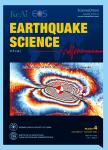Analysis of the role of diffraction in topographic site effects using boundary element techniques
Analysis of the role of diffraction in topographic site effects using boundary element techniques作者机构:Departamento de Ingeniería Civil Universidad EAFITMedellín Colombia
出 版 物:《Earthquake Science》 (地震学报(英文版))
年 卷 期:2013年第26卷第5期
页 面:341-350页
学科分类:070801[理学-固体地球物理学] 07[理学] 0708[理学-地球物理学] 070102[理学-计算数学] 0701[理学-数学]
基 金:conducted with financial support from ‘‘Investigaciones Geote'cnicas Solingral S.A’’ Departamen to Administrativo de Ciencia Tecnología e Innovación COLCIENCIAS and from Universidad EAFIT through research Grant 1216-502-27173 under contract 509-2011
主 题:Seismic site effects Topographiceffects Elastic wave scattering Diffractionof in-plane waves
摘 要:The role played by the diffraction field on the problem of seismic site effects is studied. For that purpose we solve and analyze simple scattering problems under P and SV in-plane wave assumptions, using two well known direct boundary-element-based numerical methods. After establishing the difference between scattered and diffracted motions, and introducing the concept of artificious and physically based incoming fields, we obtain the amplitude of the Fourier spectra for the diffracted part of the response: this is achieved after establishing the connection between the spatial distribution of the transfer function over the studied simple topographies and the diffracted field. From the numerical simulations it is observed that this diffracted part of the response is responsible for the amplification of the surface ground motions due to the geometric effect. Furthermore, it is also found that the diffraction field sets in a fingerprint of the topographic effect in the total ground motions. These conclusions are further supported by observations in the time-domain in terms of snapshots of the propagation patterns over the complete computational model. In this sense the geometric singularities are clearly identified as sources of diffraction and for the considered range of dimensionless frequencies it is evident that larger amplifications are obtained for the geometries containing a larger number of diffraction sources thus resulting in a stronger topographic effect. The need for closed-form solutions of canonical problems to construct a robust analysis method based on the diffraction field is identified.



